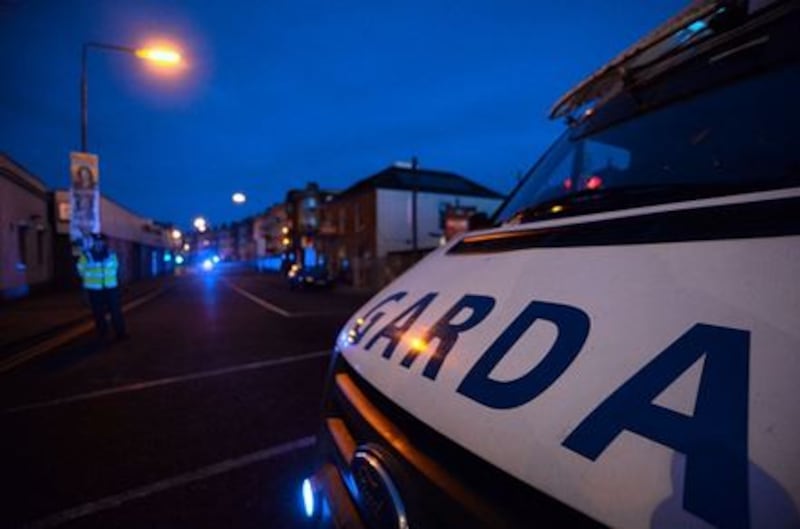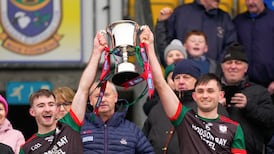After the weekend's events in Navan, which saw another dismal instance of a GAA referee having to be given a police escort off the field because some spectators can't behave themselves, it's a pleasant diversion to reflect on some of the more positive engagements between the GAA and An Garda Síochána.
It comes in the shape of a handsome volume, lavishly illustrated with photographs, charting the history of the force and its involvement in Gaelic games. Guardians of the GAA is by Brian Willoughby and Noel Hynes, both gardaí, one serving and the other retired.
If this sounds too small-focus a tale to be of interest to the world at large, that would be a misleading impression. The force is as central to Irish life as the GAA itself, with a presence in communities up and down the country, and the shared experience has been inevitable.
Even before the foundation of the state there was a surprising influence in the presence of an RIC officer, Thomas St George McCarthy, at Hayes's Hotel in Thurles on November 1st, 1884 when the GAA was established at a meeting convened by Michael Cusack.
McCarthy probably attended as a result of his friendship with Cusack, whose academy he had attended, and doesn’t appear to have had a major role in the association in the years that followed – hardly surprisingly given his calling, which was ostracised in the rulebook only four years later.
From Tipperary, McCarthy played rugby for Ireland in 1882 and, although he faded from view in terms of the GAA, he later attended All-Ireland finals all but anonymously and was in 1934 the only surviving founder of the association still alive for its golden jubilee.
Rehabilitation
Former Armagh footballer Jarlath Burns helped to drive McCarthy's rehabilitation and, in his role as chair of the GAA's 125th anniversary committee, organised a headstone for the previously unmarked grave in Deansgrange cemetery in Dublin.
When the state came into being and a police force had to be established, the first Garda commissioner was Eoin O'Duffy, a member of the Clones Harps club in Monaghan and former secretary of the GAA's Ulster Council.
The spin-off for the GAA... was that young men enthusiastic about the games were being stationed all over the country
Although O'Duffy's public career crashed and burned into the embarrassment of his embrace of fascism with the Blueshirts and the Irish Brigade he took to the Spanish civil war, he was at the height of his powers a charismatic leader and a brilliant organiser. As the first Garda commissioner, he played an influential role in the growth of Gaelic games in the fledgling State.
A 1923 circular urged gardaí to join football, hurling and athletic clubs as a means of keeping fit, but more significantly as a way of participating in their communities.
The spin-off for the GAA, still bruised by the impact of the struggle for independence and the Civil War, was that young men enthusiastic about the games were being stationed all over the country. The book focuses on one village, Partry in south Mayo, where three gardaí – John McGahern (no relation to the author, whose father was in the force), Michael Smyth and Martin Reynolds – played a big part in revitalising football.

Dedicated Garda clubs were formed in Dublin, Cork and Limerick – the latter becoming the first of them to win a county title, the 1924 football championship.
The Dublin club, famous for fighting proxy city-country wars with St Vincent's in the 1940s and '50s, produced the only galactico All-Ireland champions when Dublin won the 1927 Liam MacCarthy with a team backboned by gardaí stationed in the city.
Best-ever haul
That year gave the force their best-ever haul of All-Ireland medals: nine of the starters and 14 of the panel were serving gardaí.
They gave Cork their worst beating ever in a final – by 14 points, 4-8 to 1-3 – and this wasn't because of some systems failure in Munster. That year's intervention by "Dublin" (none of the team were Dubliners) prevented Cork from doing four-in-a-row, as they won the 1926, '28 and '29 All-Irelands.
PD Mehigan in The Irish Times wrote that Cork had been "out-paced and out-played by probably the best 15 hurlers who have ever contested a championship final".
Names like Garrett Howard (Limerick and Tipperary), Pat "Fowler" McInerney (Clare) and Tommy Gill (Galway) featured. A year later the rules were changed to allow players to return to play with their own counties, and most availed of the opportunity.
As the 20th century progressed, better cars and roads meant that there was less need for those stationed elsewhere to play for their county of residence and to an extent that influence waned but by no means disappeared.
At a time when apparently endless controversy stalks An Garda Síochána, this is an unashamed celebration of the force at its best
There are also sobering reminders of other ways in which members of the force are different: on the front line between criminality and the community. John Morley, the renowned Mayo footballer, and Séamus Quaid, originally from Limerick but who won an All-Ireland with Wexford at wing forward in 1960, were both murdered in the line of duty within a few months of each other.
There are too many stories and features to list them all, but one example is worth mentioning: the painstakingly researched and annotated index of every garda to have played inter-county, including Waterford's Niamh Briggs, who went on to captain the Ireland women's rugby team to a Grand Slam.
At a time when apparently endless controversy stalks An Garda Síochána, this is an unashamed celebration of the force at its best, engaging with the community and producing role models and heroes.
An arresting read.
Guardians of the GAA – A Compilation of Garda GAA Players by Brian Willoughby and Noel Hynes is available from various retail outlets and kennys.ie at €20















